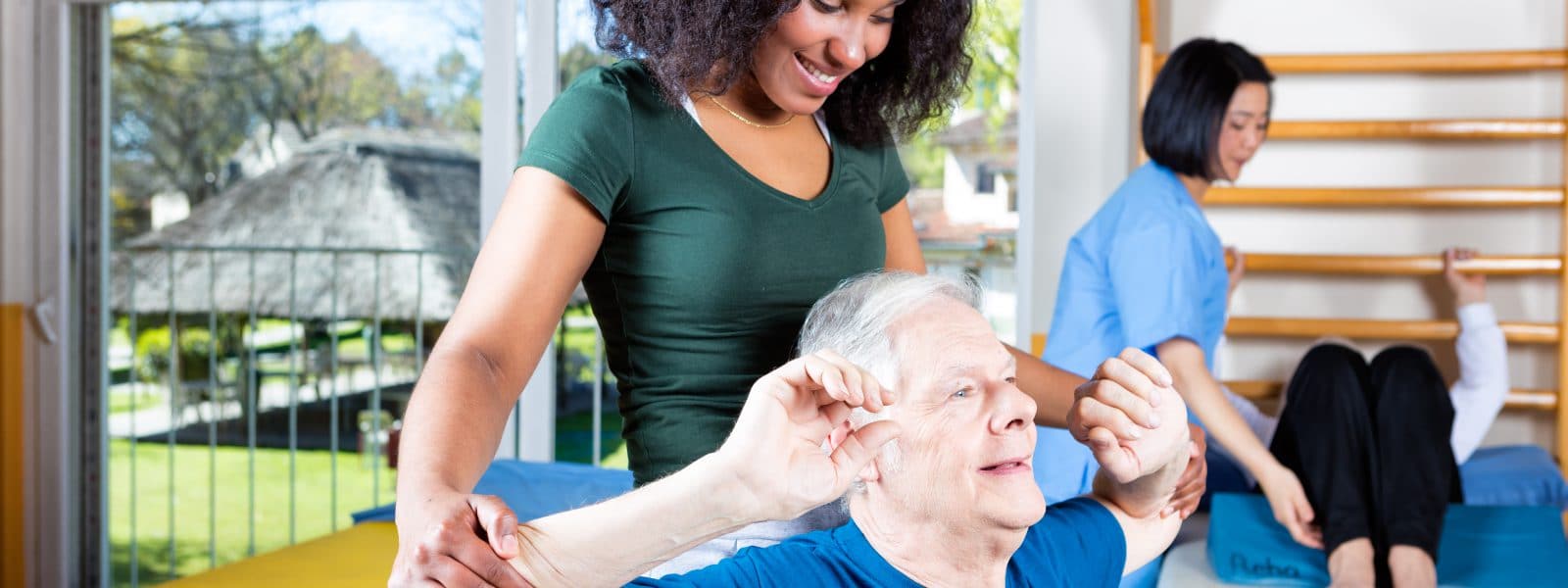5 Key Lessons of COVID-19 for Skilled Nursing Facilities

Long-term care facilities have been, in many ways, more acutely impacted by the COVID-19 pandemic than in any other type of institution. Few other industries have such direct & comprehensive responsibility for the well-being of the most vulnerable members of our society.
Despite unprecedented challenges, many skilled nursing facilities have navigated the pandemic without catastrophe. Indeed, the experience of managing the pandemic, as well as its secondary & tertiary effects on facilities & their operations, has imparted many valuable lessons for SNF administrators & caregivers.
We spoke with Kristin Thrun of Chicago-based Jordan Healthcare Group about her experience as administrator of a 100-bed SNF over the course of the pandemic. Kristen’s observations revealed 5 key lessons of managing COVID-19 in skilled nursing facilities that administrators & caregivers must take to heart in the months & years ahead.
1. Communication is absolutely essential
In the early stages of the pandemic, before her own facility had its first confirmed case, another SNF in the Chicago area had a significant COVID outbreak.
“They were getting a lot of negative media attention,” Kristin recalled. “The media were interviewing a lot of family members, and we noticed that when the family members would talk about what were their biggest concerns, it was all related to communication. They didn’t know what was going on with their loved ones.”
Indeed, many SNF’s experienced negative media coverage, especially during the early phases of the pandemic. Kristin & her team realized that consistent, accurate communication was absolutely essential, and created a plan to keep all stakeholders informed & up-to-date.
“We took our management team and we split them in half,” she explained. “One team continued to work onsite, and the other team began working from home. That way, in case the people who were going into the building every day got sick, we would have people to come in & replace them, so we would always have management in the building.”
But the remote team had a vital job, even while away from the facility. “The people who were at home, they were our communicators.”
Communication with families
During the early stages of the pandemic, regular, personal communication with patients’ families was a necessity. This proactive outreach helped reassure families that their loved ones were in good hands.
“Every single day, we called the patients & their families,” Kristin recalled. “We gave the families an update on the status of the facility, & just spent time talking to them. A lot of it was easing fears, because a lot of people didn’t know what to expect.”
Kristin’s experience mirrors that of many providers & administrators around the country. Prompt, transparent, empathetic communication, from the whole team, is key to allaying concerns of family members.
“That daily communication helped us stay ahead of any potential problems, because whatever concerns that the families had, we could address right away. I think that’s ultimately what saved us. We didn’t have any families really have any complaints.”
Communication with staff
Kristin also stressed the importance of consistent & intentional communication with staff.
“Things were changing frequently, and no one fully knew what was going on. So, we were very transparent with our staff. We told them, ‘Listen, this is what we know right now. Here are the steps we’re taking. This is what we’re doing to protect you.’”
The work-from-home communications team created a daily communication for staff, posted on the staff website. This allowed staff to stay apprised of updates, even while not at the facility. The online update contained key information such as protocol & procedure changes, reports on how many patients & staff had tested positive, and important matters.
The communications strategy worked. While many facilities struggled to retain staff, Kristin’s facility only lost two staff members during the pandemic, and both left for personal reasons unrelated to COVID. “There was a lot of learning,” she reflected. “The experience of really listening to our patients, their families, our staff, and even the media & our competitors’ customers, really helped us through the process. And, obviously, communication & transparency are of the utmost importance, with patients, families, & staff. They need to know what you’re doing, & how you’re caring for their best interests at all times.”
The diligent communications efforts of Kristin’s team helped to strengthen relationships throughout the facility. And strong relationships, at every level, were another key to their success in navigating the pandemic.
2. Relationships are vital
Throughout our conversation, Kristin mentioned key relationships with other organizations, and described how these relationships helped her facility resolve the critical & unexpected issues that arose during the pandemic.
Industry associations take the lead
“When we had to develop protocols for our COVID unit, we weren’t getting a lot of guidance from either state or federal public health departments,” she said. “We actually ended up relying very heavily on our state & national associations to help give us answers regarding what were the best practices.”
Kristin’s facility already utilized many resources from their association, but such guidance took on more urgency during the pandemic. “Both our national & state associations have historically been good at communicating, so that was already a strong area for us. But also, I think many facilities that didn’t typically use them before found them as a great resource.”
The importance of reliable suppliers
Strong relationships with suppliers were a necessity. The shortages of key items, that occurred early in the pandemic, placed an unexpected strain on many of these relationships.
“It’s important to have different contractors in place, other than just the typical vendors people rely on for medical supplies,” Kristin said. “We’ve identified a lot of alternative sources for things like PPE & cleaning supplies. We’ve included all that in our emergency plan now.”
Seek insights from colleagues in other facilities
Conference calls with hospital groups have also provided solutions to many issues.
“We participate in different hospital groups, and people share some of the practices they’re doing,” Kristin told us. “We evaluate those to see if they’ll work for us. It’s interesting, because a lot of things are dependent on what resources each facility has available, so people’s protocols are very different. But there has been a lot of sharing of innovation through those meetings. There are a lot of SNF’s doing very innovative things to meet the needs of their patients, their customers, their key stakeholders.”
3. With diligent practices, the pandemic can be controlled
Using this combination of innovative practices & attention to basics, Kristin & her team were ultimately able to limit the spread of COVID within their facility.
“We learned that with good infection control, good source control, you really can limit the transmission of this disease,” she said. “We’ve had asymptomatic staff test positive, yet none of our residents get sick. That tells us there’s good source control, that we’re following the right procedure.”
Some of the most significant factors that contributed to this success included:
- Maintaining inventory of cleaning supplies, PPE, & other essentials
- Helping residents to adapt to the changes in daily routine
- Creating safe visitation procedures for families
- Training of staff in infection control procedures
- Low staff turnover
It’s important to note that all of the above depended on active communication & strong relationships.
Regarding training, Kristin specifically recommended the Nursing Home Infection Preventionist Training course developed jointly by the CDC & the Centers for Medicare & Medicaid Services.
“It’s an in-depth program that gives SNF’s access to top-quality education, for as many staff as they want, at no cost. I think that’s fantastic, because one of the biggest barriers that has prevented SNF’s from providing that kind of training has been expense. You might train a staff member, then they leave, & you have to train someone else. With high quality free resources, that’s not an issue.”
4. COVID has created an opportunity for improvement across the industry
We asked Kristen if there were any good things she saw as a result of the pandemic. “Anytime you have a chaotic situation, innovation is born from it,” she reflected.
These rapid innovations have been an unexpected upside of the COVID pandemic. Over the course of our conversation, she identified several key areas of positive change.
Improved collaboration with regulatory agencies
Both federal & state agencies have provided additional resources for SNF’s during the pandemic, and in many cases, this unprecedented support has been effective & beneficial for day-to-day operations, & has helped facilities to contain the pandemic.
“I think the emphasis the CDC is putting on infection prevention & training, and the resources they’re providing, has been a really big benefit. In Illinois, HFS has also dedicated a lot of resources to infection control for SNF’s.
“As far as increased support from government & regulatory agencies, I’m excited to see what that will look like. Historically, in SNF’s, we don’t usually get the carrot, we’ve usually gotten the stick, especially from the government. I’m eager to see if there’s going to be more collaboration with government entities going forward, as opposed to just a regulatory or punitive approach.”
Of course, along with increased government resources, the pandemic has also brought increased scrutiny of the industry from regulators.
Better communication & customer service
While communication with various stakeholders has always been important for SNF’s, the pandemic highlighted the need for robust communications procedures, that would function smoothly even in chaotic situations.
“Prior to the pandemic, we were already using an app called Safekeeping to do basic communication with our families,” Kristin told us. “We’re planning to build on that in the future, so we can send alerts to the families via the app.”
Developing systems to take advantage of efficient technologies, while still maintaining a personal, empathetic relationship with patients & families, can be a challenge.
“During the pandemic, communication was more time consuming,” Kristin said. “It wasn’t just because we had to share a lot of information, but also because our team also needed to be sensitive to some of the emotional baggage that family members were dealing with, as they were experiencing the crisis for themselves.”
Kristin & her team were ultimately very successful with their communication strategy, managing regular, personal communication with over 100 families, through a period of intense stress & uncertainty.
“During the height of the pandemic, I think more personal communication was necessary,” she told us. “But you also need to figure out when it’s appropriate to pull that back, & redirect your resources to other things.”
The whole experience provided valuable lessons that they will apply to the management of the facility in the years to come. All stakeholders in the facility will likely see the benefits of improved communication routines.
Taking advantage of opportunities as they present themselves
It will be some time before SNF administrators can assess the full effects of the COVID pandemic on their facilities, as well as its impact on the industry overall.
“This pandemic is going to change the way we operate, I think not just over the next year, but possibly over the next couple of years,” Kristin suggested. Given the uncertainty surrounding the pandemic itself, it’s difficult to predict how regulations may change in the future.
However, it seems that the temporary regulations are a major step forward in one particular area: telehealth.
5. The emergency telehealth rules are a huge improvement
Another major opportunity to emerge from the pandemic is the shift towards telehealth. The emergency telehealth regulations have allowed SNF’s to explore the benefits of telehealth, and during our conversation Kristin identified major advantages of telehealth in several key areas, including:
- Enhanced collaboration & communication between physicians & staff
- Limiting exposure of very sick patients
- Reducing stress & risk associated with travel to appointments
- Reducing costs while simultaneously improving care
While it remains to be seen what will happen with telehealth regulations after the COVID pandemic, SNF stakeholders have begun to appreciate its merits.
Improved communication & collaboration between offsite physicians & SNF staff
Having appointments onsite, with an SNF staff member present, has facilitated much better communication between physicians & facility staff.
“Where I’ve seen a huge benefit is that there’s more collaboration between the SNF & the specialists around the patient’s plan of care,” Kristin told us. “Before, we would send someone to an appointment, and we would get a note back. Sometimes, we couldn’t even read the note, so maybe the patient would say what happened, but we’d still have to call the doctor to confirm, and there would be a lot of confusion.
“But with the telehealth visits, our nurse actually participates, together with the specialist & the patient. There’s a lot of collaboration, so we can share things about what’s going on with the patient’s care, whatever is relevant to the specialist. And, they can share the treatment plan with us, and we can update orders right then & there. I think that has been a huge benefit that has come out of this crisis.”
Many in the SNF industry have also noted that telehealth platforms make it easier for SNF staff to get support from specialists, which is especially important when onsite physicians may be unavailable.
Reduced exposure & stress for patients
For patients who are in poor health, leaving the SNF for travel to & from appointments is a major stress. Increased use of telehealth has greatly reduced this stress & associated risk.
“From a patient perspective, when they’re not going out to an appointment, they’re not getting additional exposure,” Kristin observed. “A lot of our patients are pretty sick. Sometimes patients couldn’t even go to their follow-up appointments, because they had to go by ambulance, and the doctor’s office couldn’t accommodate a stretcher. In cases like that, we were able to give the doctor access to that patient without having to deal with those barriers.
Reduced transportation costs
In addition to improving quality of care & reducing stress & risk, the COVID telehealth rules have actually reduced the SNF’s costs related to facilitating patient appointments.
“For doctors whose offices could accommodate a stretcher, that ambulance ride back & forth is expensive, and it falls under consolidated billing, so the SNF is paying for it,” Kristin noted. “Often, that would be four or five hours to send a person to an appointment. So there’s a significant cost savings from telehealth there.”
Improved efficiency & reduced waste
The direct collaboration between SNF staff & offsite physicians during telehealth visits also improves efficiency & reduces costs. Previous studies have concluded that telehealth reduces the cost of care, and the increased use of telehealth in SNF’s has confirmed that there are significant cost savings.
“I think, just purely from improved communication, we’re probably seeing cost savings in terms of improving the efficiency of care & reducing waste,” Kristen noted. “For example, sometimes if we were sending a patient to an orthopedic appointment, we may order an X-ray, but then the doctor might order another X-ray. Now that we’re doing telehealth, we just send them our X-ray. I’m sure there’s indirect cost savings through that improved communication.”
While harder to measure in the short term, these benefits are becoming more clear over time. Indeed, some researchers have been suggesting that telehealth will improve efficiency & reduce waste for many years, and the COVID telehealth rules might finally prove them right.
Now is the time to review systems & develop plans
The COVID-19 pandemic caught almost everyone by surprise, within the SNF industry, in the healthcare system overall, and in society at large.
However, if another pandemic were to occur in the future, no one should be caught off guard.
Kristin & her team have already conducted a new hazard vulnerability assessment (HVA) & updated protocols to account for the risk of a pandemic. “Usually, we do our HVA’s in January,” she told us. “The HVA is part of our emergency preparedness planning, to identify what risks are most significant to our facility. Historically, our most significant risks have been weather-related, and in the past few years active shooter has been a concern. Pandemic was always very low, because since the Spanish flu of 1918, there hasn’t really been a pandemic per se.
“Now, in our updated HVA, pandemic is much higher on the list of potential risks, and we’ve updated our entire emergency plan based on that.”
Some of the most important updates to their HVA include:
- Dividing management into onsite & work-from-home teams
- Strategies & procedures for reliable & consistent communication with patients, families, & staff
- Improved training of staff in infection control procedures
- Maintaining appropriate stockpiles of PPE & cleaning & sanitation supplies
- Developing a list of alternative vendors for critical supplies, in case of shortages
While there are numerous challenges managing COVID-19 in skilled nursing facilities, our experience has shown that it is possible. Indeed, this experience has imparted many valuable lessons for our company, as well as for the facilities where we work.

